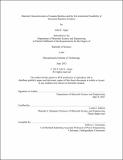Material characterization of Guadua bamboo and the environmental feasibility of structural bamboo products
Author(s)
Aijazi, Arfa N. (Arfa Nawal)
DownloadFull printable version (4.819Mb)
Other Contributors
Massachusetts Institute of Technology. Department of Materials Science and Engineering.
Advisor
Lorna J. Gibson.
Terms of use
Metadata
Show full item recordAbstract
Bamboo has long been used in vernacular construction because of its high strength, rapid growth rate, and global abundance. Bamboo is increasingly being used in contemporary architecture as a sustainable alternative to wood and other building materials. Forming bamboo into a structural composite can improve mechanical performance, durability, and joining, which can open up new structural applications and design possibilities as well as remove the stigma that bamboo is the "poor man's timber". This study aims to characterize the radial and longitudinal variation in the microstructure and mechanical properties of Guadua bamboo (Guadua angustifolia kunth) in order to inform efficient material use in a composite. The study found a linear relationship between the MOE, MOR, and compression strength with density. Through analysis of micrographs, the density was correlated to the area fraction of sclerenchyma fiber sheaths. Results from nanoindentation confirmed that the fiber properties did not vary with position. Further the environmental impact in the form of exhaustion of energy found that processed bamboo had a mechanical advantage over raw bamboo culm and lower energy input in manufacturing but superior performance in comparison to wood composites.
Description
Thesis (S.B.)--Massachusetts Institute of Technology, Dept. of Materials Science and Engineering, 2013. This electronic version was submitted by the student author. The certified thesis is available in the Institute Archives and Special Collections. Cataloged from student-submitted PDF version of thesis. Includes bibliographical references (p. 52-55).
Date issued
2013Department
Massachusetts Institute of Technology. Department of Materials Science and EngineeringPublisher
Massachusetts Institute of Technology
Keywords
Materials Science and Engineering.